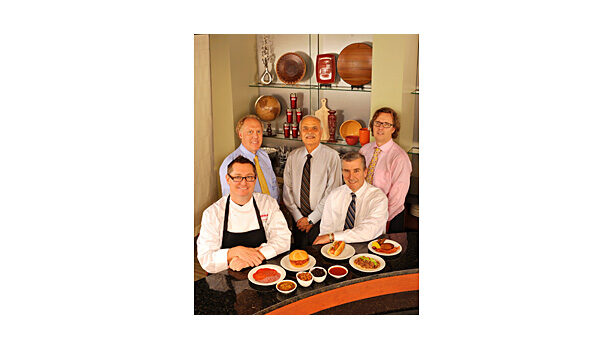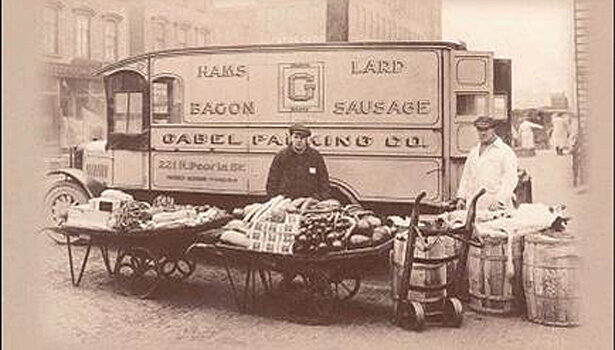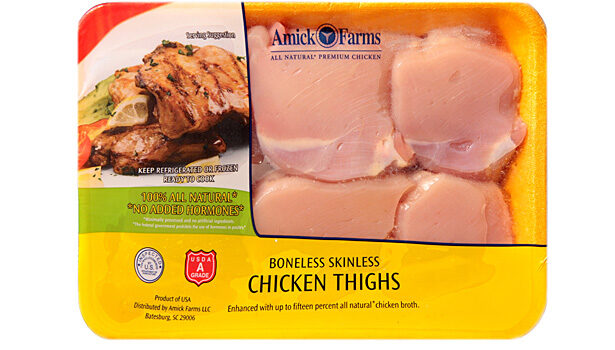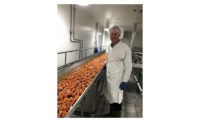OSI "Meats" Customer Needs, Day In and Day Out
OSI Group is a customer-centric organization that brings scale, flexibility and brand integrity to the table.












Since OSI Group opened its first family meat market in Chicago in 1909, one thing has remained steadfast—its unwavering dedication to its customers’ success.
“We design our entire business around our customers’ needs,” says Kevin Scott, executive vice president, North America for OSI Group, LLC, based in Aurora, Ill. “They’ve entrusted us with their brands, and that’s a stewardship we take very seriously. We have a select group of customers, which allows us to focus on understanding their unique needs. We look to form deep relationships—this creates a winning partnership mindset.”
But, it’s not just the winning partnerships that have allowed OSI to “meat” customers’—and consumers’—needs day in and day out. The global meat processor continues to expand globally, opened a new culinary innovation center, established a new supply chain global trading platform and its chairman and CEO Sheldon Lavin was inducted into the 2013 Meat Industry Hall of Fame. That’s why OSI was named Refrigerated & Frozen Foods’ 2014 Refrigerated Foods Processor of the Year.
The world of food solutions
OSI is a concept-to-table, full-service processor of hot dogs, lunch meat, dried sausage and cook-in-bag items, along with a number of frozen applications for foodservice and retail. All products are produced on an as-needed basis, allowing for customization and flexibility.
“Over the last five years, we’ve re-tooled our organization to offer the speed and flexibility that we need to be successful in the marketplace today,” Scott says. “And, it goes back to both the retail and foodservice channels, this need to move much quicker than we’ve ever had to in the past.”
While the distribution channels continue to transform, so do consumers and their ever-changing needs. Convenience, for example, continues to drive consumer behavior, Scott adds. As a result, OSI offers convenient, fully prepared solutions, whether it be pre-sliced sausage or pre-cooked products ready to serve.
Portability is also a growing trend, as more and more people are eating on the go and in different places and at different times.
“Rather than having traditional meals where I can have my protein prepared and served for me in a certain format, now it’s about putting protein in a dough-enrobed item, for instance, so consumers can grab it and eat on the go. Or, placing the protein in a wrap, so they can carry it and eat it on the run,” Scott says. “The [distribution] channels have become so blurred that now it’s about how we as suppliers can support these evolving needs. How do we as manufacturers generate packaging that allows our food to be efficiently placed in every environment, whether it be a drug store, mass merchandiser, club store or a gas station or an emerging channel? Our packaging systems need to be robust enough to deliver that food experience regardless of the channel.”
That’s why OSI invested in new packaging systems.
“A lot of our packaging enhancements are driven by our demand creators, which in essence is our customers,” Scott says. “We find more customers looking for less ingredient line content, thereby requiring the product itself to shine more rather than be enhanced through artificial ways. But, they’re also looking for more individualized products. Personalization is key.”
Staying on top of trends also means introducing the right flavor profile in the right way.
“We have traditional carriers that now become vehicles for flavor delivery, i.e., burgers that were once just beef now have other toppings embedded within them to create that flavorful experience. The same with other carriers like meatballs and the like,” says Scott. “The reality is that the Millenials and even the next younger generation are looking for bold flavors in a big way.”
To keep up with demand, in 2011, OSI opened a new Culinary Innovation Center (CIC) that houses chefs and food scientists who create, test and present new product concepts and then sends them down the street to OSI’s fully equipped 10,000-square-foot R&D center to produce on-site prototypes.
“Everything we produce is in essence built for a specific customer or customers’ need. We tend to forge deep and integral relationships with our customers. That fabric then creates the transparency and the alignment that drives us to meet or exceed their needs,” says Scott. “The CIC takes our core processes and creates miniaturized versions to get us products in a quick turnaround for the customers. It goes back to the whole theme of speed and flexibility. The CIC and R&D center are the catalyst to ideation, development and eventually the solution.”
Likewise, the ideation of new product development comes from balancing OSI’s capabilities against today’s market trends.
“Recent advances in ingredients and packaging materials have enabled us to have cleaner labels and fresh-tasting product with longer shelf life,” says B.K. Girdhar, vice president of product development and technical services. “We work very closely with the ingredient suppliers and use their expertise and pilot facilities to come up with prototypes and then test the performance through shelf life studies.”
One sustainable company for one eco-friendly world
What makes OSI unique is its ability to be all things to all people. For example, to maintain a safe and secure supply chain, OSI works with its vertically integrated partners from around the world to produce all of its raw materials. In fact, OSI owns and operates their own slaughter operations, chicken processing plants, feed mills and hatcheries in China and Europe, among other locales.
“What that allows us to do is really be a supply chain solution for our customers, not just simply a converter of that raw material and not just simply a designer of their products,” adds Scott.
When it comes to sustainability, “we have to be more efficient with the resources we have, whether they be economic or supply chain,” Scott says. “The word sustainability is a word that’s used a lot to encompass a lot of actions that were being carried out before. But, it’s also a word that rallies us to think about our impact in different ways. Once you focus on something, you can make results happen.”
That’s why in late 2013, OSI took the first step by announcing a new global trading platform. MPO (Meat, Poultry & Other) Global Trade, GmbH, located in Günzburg-Denzingen, Germany, will now operate as OSI’s global trading platform, focusing on poultry products from Brazil and Thailand, for starters. MPO (an OSI Group company) will support both the primary processing and further processing assets in Europe and Asia.
OSI also has plans in place to tackle other sustainability initiatives such as reducing waste-to-landfill and water usage.
“We have developed several creative outlets for hard-to-recycle products to meet our goal of 90% by 2020. [Milestones have been set at 70% for 2013],” says Larry Glaser, assistant vice president and director of operations and process improvement. “Reducing water usage is another project we are working on, eliminating uses for water that can be achieved by a closed system. Examples are using glycol chilling systems to replace water-cooled hydraulic systems on equipment.”
Through its corporate logistics team, OSI has applied cube optimization, intermodal transport and freight consolidation to save 8,200 metric tons of greenhouse gases from entering the atmosphere on an annual basis, Glaser adds. OSI also installed measures to control its energy costs.
“Installing measuring systems first and utilizing technology to bring our data closer to real time and place is helping us address these opportunities more quickly,” Glaser adds. “Our factory lighting upgrades are almost complete, and with an expected savings of around 5% of our energy bill, the ROI is quick. Using new controller systems, variable speed motors and other improvements on an aging refrigeration system will further improve our energy usage.”
Other sustainability initiatives for the West Jordan, Utah, plant, for example, include its participation in OSI’s zone-wide sustainability data management system, which tracks, evaluates and takes action on achieving its sustainability goals. Additionally, the West Jordan site was recognized by the American Meat Institute for its sustainability program standards and has received several of the highest safety citations in the industry for developing a safe and healthy workplace. (For more about the West Jordan plant, go to “Redefining State-of-the-Art” on page 36).
Regardless of the order, OSI brings customization, flexibility, speed and brand integrity to the forefront of all of its partnerships, which allows it to “meat” the needs of its customers day in and day out.
The Amick Farms Difference
It’s all over the news—cattle prices are at a record high and beef prices continue to rise, as of press time, and will continue to rise or maintain higher-than-normal costs through 2014, according to economists. As a result, foodservice companies are looking for cheaper sources of protein and chicken, thus increasing demand for boneless items, says Ben Harrison, president of Amick Farms.
Thankfully, Amick Farms, a Batesburg, S.C.-based division of OSI Group, provides what it calls “The Amick Difference.”
Amick Farms is a fully integrated processor of premium grain-fed chicken breasts, thighs, tenderloins, drumsticks and individually quick frozen boneless breasts, wings, tenders and more for retail as well as boneless breasts, tenders, wings, thighs, drumsticks, whole legs, leg quarters and whole birds for foodservice.
“Being competitive in all the key performance measures on the live side of the business has increased in importance,” says Harrison.
That’s why the poultry processor continues to evolve with ever-changing industry trends. From a packaging standpoint, for example, Amick Farms migrated to the smaller sealed bags that now feature artwork and recipes.
“Many of today’s consumers want to purchase poultry without ever handling the product,” Harrison adds.
From a sustainability standpoint, Amick Farms’ water usage stands at only 4.5 gallons per bird, against an industry average of 6 gallons per bird.
X-ray technology has also improved quality control and food safety.
“We are using enzymes in our feed to increase the bird’s ability to digest all the nutrients in the feed and therefore, lower our overall feed cost,” says Harrison.
Amick Farms also revamped its Contractor Safety Program to enforce training procedures in light of construction projects.
“We have implemented an Amick Farms Machine Safeguarding Project Team. This team’s mission is to be proactive in finding areas where we can improve the machine guarding,” Harrison says. “We also added computerized training systems to complement our in-person training program. The Animal Welfare, GMPs and Global Harmonized System videos have allowed us to more consistently communicate to our associates.”
Amick Farms also continues to use commercial carriers for delivery, but is revamping its production systems to produce products to order, thus reducing the time carriers wait for an order to be completed.
Between packaging enhancements, sustainability initiatives and increased food safety measures, Amick Farms’ culture of quality and performance certainly provides the Amick Farms Difference.
CLICK HERE to take a tour of OSI's West Jordan, Utah, facility, which features hands-free automation that's simply out of this world. And view our photo gallery to check out more pictures from the OSI photo shoot.
Company: OSI Group, LLC
Headquarters: Aurora, Ill.
Top Executive: Sheldon Lavin, chairman, CEO
No. of Employees: 20,000 worldwide
Distribution: Global
Channels: 70% foodservice; 30% retail
Annual Sales: $6.125 billion in 2013
Looking for a reprint of this article?
From high-res PDFs to custom plaques, order your copy today!












